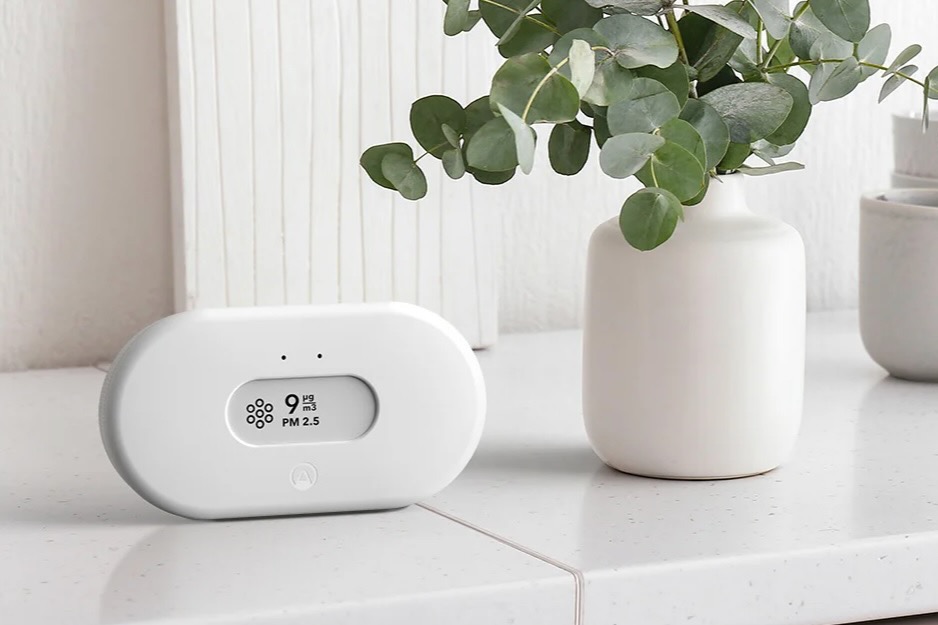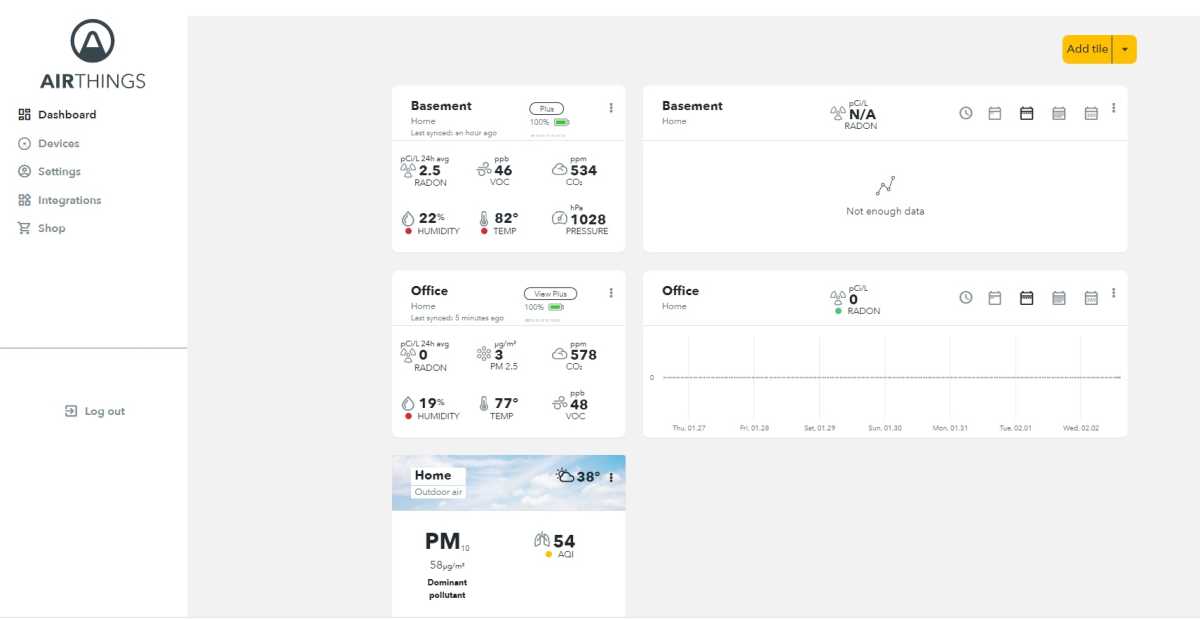At a glance
Expert’s Rating
Pros
- Integrated hub and sensors
- Can use older Airthings hardware
- App or web-based interface
- Excellent notifications and alerts
- Works with Alexa and Google Assistant
Cons
- Very big
- Expensive
- Doesn’t monitor carbon monoxide
- Can take a month to calibrate sensors
Our Verdict
With seven air quality sensors and the ability to act as a hub to add more, the Airthings View Plus can tap into Alexa or Google’s Assistant to put its air quality data to good use. That said, the lack of a carbon monoxide monitor is a missed opportunity.
Price When Reviewed
$299
Best Prices Today
$299.99
Free
Housed in a white oblong case, the Airthings View Plus air quality monitor takes smart home multitasking to the limit. It not only has seven built-in monitoring sensors, but it can act as a hub to add many more, displaying the results on its interactive screen, on the Airthings app, or over a web-based interface. At 6.6 x 3.5 x 1.2 inches, the 12.8-ounce View Plus is also on the large side, dwarfing the competing Aqara TVOC Air Quality Monitor (which measures just 3.0 x 1.6 x 0.6 inches).
The View Plus’s 2.9-inch e-paper screen gets updated every 2.5 minutes and shows the sensor’s results one or two at a time. It’s easy to go between them by swiping your hand in front of the screen, and an LED above glows green when the air is good, yellow when you might want to open a window, and red when it’s time to get some fresh air.
This review is part of TechHive’s coverage of the best indoor air-quality monitors, where you’ll find reviews of competing products, plus a buyer’s guide to the features you should consider when shopping.
Besides its ability to detect radon (it’s one of a handful of air quality monitors that can do so), the Airthings View Plus can identify 2.5-micron particulates and volatile organic compounds, while measuring temperature, relative humidity and air pressure. It also has a cool feature that combines temperature and humidity readings to estimate the risk of mold growing, perfect for a damp basement or attic. The device can send alerts once any pre-set threshold is reached, and it occasionally delivers wellness hints, such as “Breathe better, live better.”

The View Plus may be big, but it can blend into any décor.
Airthings
Inside the Airthings View Plus
The View Plus is a dual-purpose device that can be self-powered by its included six AA batteries. The company estimates that the cells should be good for about two years of use. You can also power the device using a USB cable, and doing so lets the View Plus act as a hub for other Airthings sensors. That’s a nice bonus, but while an USB cable is included, an AC adapter isn’t.
Priced at $300, the feature-packed View Plus is on the expensive side; for example, the competing Aqara TVOC Air Quality Monitor is just $45. Then again, the TVOC device only has sensors for three air quality parameters and can’t act like a hub for adding others.
The View Plus includes a one-year warranty and lifetime support from the company’s Web site, online chat window or a phone call.
 The air sensors and Wi-Fi connection are powered by six AA batteries or a USB connection.
The air sensors and Wi-Fi connection are powered by six AA batteries or a USB connection.
Brian Nadel/IDG
Setup
Installing and configuring the View Plus is quick and easy, but it can take a month for its sensors to self-calibrate. In other words, it’s not for those seeking instant gratification.
My first step was to install and launch the Airthings Wave app on my Samsung Galaxy S20 phone. I then created an account with Airthings, tapped Add Device, and allowed the app to use the phone’s GPS location. After the screen showed a six-digit number, I entered it into the app and proceeded to connect it with my home Wi-Fi network. Finally, I picked a room and home for the device and allowed it to use my location data to add weather reports and warnings.
Later, I set up the optional Wave Plus sensor array (AirThings sent me the $230 sensor along with the View Plus review unit) in my basement. The Wave Plus uses older 933MHz wireless technology, but it integrated with the View Plus’s hub in about four minutes. Besides reading levels of radon, volatile organic compounds, and carbon dioxide, the Wave Plus can also monitor temperature, humidity and air pressure. The Wave Plus lacks the display of the View Plus but has a red-yellow-green LED ring to show overall air quality.
My last step was to hang the monitors. While the View Plus has inset holes for wall mounting, the Wave adds a magnetic backing plate for placement on a metallic surface, like a basement air duct or furnace.
Using the Airthings app
The AirThings Wave app is available for Android and iOS systems, loads quickly, and can tell you about the current air quality. It’s organized by room and can accommodate setting up sensors in several houses.

The app shows the air quality readings as well as an overall indication of how healthy it is.
Brian Nadel/IDG
After I tapped on the Office link, the app not only showed the overall air quality (“Fair,” based on the yellow rating) but displayed the individual readings. I tapped the arrowhead on the right to swipe through the individual readings with a fever graph of its history over time. The app works only in portrait mode, but the data can be presented in a web dashboard that works with any modern web browser.
The data can also be integrated with Alexa and Google Assistant, but it lacks compatibility with Apple HomeKit (the company is mulling future HomeKit support). With the right equipment, the View Plus can (for instance) be set to trigger a fan when the particulate level hits a certain level.

Using the web-based dashboard, the Airthings sensors can be viewed from a variety of computers.
Brian Nadel/IDG
Airthings View Plus in the real world
With its array of seven air quality monitors, View Plus proved to be an excellent way to keep an eye on the air around me. The Wave Plus add-on sensor kit worked wherever I put it in my 3,500 square foot house, showing the extended range of the 933MHz connection it uses to move the data around.
It was worth the wait for the sensors to calibrate themselves. View Plus, however, misses several opportunities. To start, Airthings is tightly focused on air quality and lacks sensors for anything like water leaks, smoke or fire. Plus, it does without sensors for carbon monoxide (to warn of a malfunctioning heating furnace) and an external thermometer (for picking what to wear).
Still, the View Plus is a great way to check on the air in your home. If it were a little smaller and cheaper, I would have liked it even better.
Brian Nadel is a contributing writer for TechHive and Computerworld and is the former editor-in-chief of Mobile Computing & Communications magazine.
[ad_2]
Originally Appeared Here